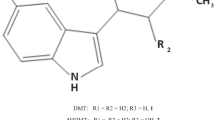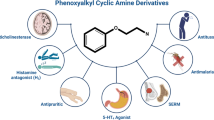Summary
The effects of several putative 5-HT1 receptorsubtype selective ligands were investigated in biochemical models for 5-HT1A, 5-HT1B, and 5-HT1D receptors (inhibition of forskolin-stimulated adenylate cyclase activity in calf hippocampus, rat and calf substantia nigra, respectively) and 5-HT1C receptors (stimulation of inositol phosphates production in pig choroid plexus). Following compounds were studied: 5-HT (5-hydroxytryptamine), TFMPP (1-(mtrifluoromethylphenyl)piperazine), mCPP (1-m-chlorophe-nyl)piperazine, 1 CGS 12066 (7-trifluoromethyl-4-(4-methyl1-piperazinyl)-pyrrolo[1,2-a]quinoxaline 1), isamoltane (CGP 361A, 1-(2-(1-pyrrolyl)-phenoxy)-3-isopropylamino-2-propranol), quipazine, 1-NP (1-(1-naphthyl)piperazine), and PAPP (LY165163, 1-[2-(4-aminophenyl)ethyl]-4-(3-trifluoromethylphenyl)-piperazine). Among reported 5-HT1B receptor selective drugs, TFMPP had similar potency at 5HT1A, 5-HT1B and 5-HT1C receptors, mCPP did not separate between 5-HT1B and 5-HT1C receptors, CGS 12066 was equipotent at 5-HT1B and 5-HT1D receptors, and isamoltane was only slightly 5-HTIB versus 5-HT1A selective. Quipazine showed equal potency at 5-HTIB and 5-HT1C receptors and 1-NP did not discriminate between the four receptor subtypes. PAPP described as 5-HT1A receptor selective, was equally potent at 5-HT1A and 5-HT1D receptors. The potencies determined in second messenger studies were in good agreement with the affinity values determined in radioligand binding studies. Thus 5-HT1A, 5-HT1B, 5-HT1C and 5-HT1D receptors have different pharmacological profiles as predicted from radioligand binding studies. Despite claims to the contrary, none of the tested compounds had actual selectivity for a given 5-HT1 receptor subtype. Of interest were the properties of several of these drugs, which behaved as agonists at some receptors and as antagonists at others (e. g. quipazine, 1-NP, PAPP and isamoltane).
Similar content being viewed by others
References
Asarch KB, Ransom RW, Shih JC (1985) 5-HT1A and 5-HT1B selectivity of two phenylpiperazine derivatives: evidence for 5HT1B heterogeneity. Life Sci 36:1265–1273
Bockaert J, Dumuis A, Bouhelal R, Sebben M, Cory RN (1987) Piperazine derivatives including the putative anxiolytic drugs, buspirone and ipsapirone, are agonists at 5-HT1A receptors negatively coupled with adenylate cyclase in hippocampal neurons. Naunyn-Schmiedeberg's Arch Pharmacol 335:588–592
Bouhelal R, Smounya L, Bockaert J (1988) 5-HT1B receptors are negatively coupled with adenylate cyclase in rat substantia nigra. Eur J Pharmacol 151:189–196
Bradford MM (1976) A rapid and sensitive method for the quantitation of micrograms quantities of protein utilizing the principle of protein-dye-binding. Anal Biochem 72:248–254
Conn PJ, Sanders-Bush E (1987) Relative effcacies of piperazines at the phosphoinositide hydrolysis-linked serotonergic (5-HT2 and 5-HT1C) receptors. J Pharmacol Exp Ther 242:552–557
Conn PJ, Sanders-Bush E, Hoffman BJ, Hartig PR (1986) A unique serotonin receptor in choroid plexus is linked to phosphatidylinositol turnover. Proc Natl Acad Sci USA 83:4086–4088
Cortés R, Palacios JM, Pazos A (1984) Visualization of multiple serotonin receptors in the rat brain by autoradiography. Br J Pharmacol 81:202P
De Lean A, Stadel JM, Lefkowitz RJ (1980) A ternary complex model explains the agonist-specific binding properties of the adenylate cyclase-coupled β-adrenergic receptor. J Biol Chem 255:7108–7117
De Vivo M, Maayani S (1985) Inhibition of forskolin-stimulated adenylate cyclase activity by 5-HT receptor agonists. Eur J Pharmacol 119:231–234
De Vivo M, Maayani S (1986) Characterization of 5-hydroxytryptamine1A-receptor-mediated inhibition of forskolin-stimulated adenylate cyclase activity in guinea-pig and rat hippocampal membranes. J Pharmacol Exp Ther 238:248–253
Dompert WU, Glaser T, Traber J (1985) 3H-TVX Q 7821: Identification of 5-HT1 binding sites as target for a novel putative anxiolytic. Naunyn-Schmiedeberg's Arch Pharmacol 328: 467–470
Dumuis A, Sebben M, Bockaert J (1988) Pharmacology of 5-hydroxytryptamine-1A receptors which inhibit cAMP production in hippocampal and cortical neurons in primary culture. Mol Pharmacol33:178–186
Engel G, Göthert M, Hoyer D, Schlicker E, Hillenbrand K (1986) Identity of inhibitory presynaptic 5-hydroxytryptamine (5-HT) autoreceptors in the rat brain cortex with 5-HT1B binding sites. Naunyn-Schmiedeberg's Arch Pharmacol 332:1–7
Furchgott RF (1972) The classification of adrenoceptors (adrenergic receptors). An evaluation from the standpoint of receptor theory. In: Blaschko H, Muscholl E (eds) Catecholamines. Springer, Berlin Heidelberg New York Tokyo, pp 283–335
Glennon RA, Slusher RM, Lyon RA, Titeler M, McKenney JD (1986) 5-HT1 and 5-HT2 binding characteristics of some quipazine analogues. J Med Chem 29:2375–2380
Gozlan H, El Mestikawy S, Pichat L, Glowinski J, Hamon M (1983) Identification of presynaptic serotonin autoreceptors by a new ligand: 3H-PAT. Nature (Lond) 305:140–142
Hamon M, Cossery JM, Spampinato U, Gozlan H (1986) Are there selective ligands for 5-HT1A and 5-HT1B binding sites in brain? TIPS 7:336–338
Herrick-Davis K, Titeler M (1988) Detection and characterization of the serotonin 5-HT1D receptor in rat and human brain. J Neurochem 50:1624–1631
Heuring RE, Peroutka SJ (1987) Characterization of a novel 3H-5-hydroxytryptamine binding site subtype in bovine brain membranes. J Neurosci 7:894–903
Hoyer D (1989) Biochemical mechanisms of 5-HT receptor-effector coupling in peripheral tissues. In: Fozard JR (ed) Peripheral actions of 5-HT. Oxford University Press, Oxford, pp 72–99
Hoyer D, Schoeffter P (1988) 5-HT1D receptors inhibit forskolin-stimulated adenylate cyclase activity in calf substantia nigra. Eur J Pharmacol 147:145–147
Hoyer D, Dravid A, Palacios JM (1987) Serotonin 5-HT1C receptor mediated hydrolysis of inositol lipids in pig choroid plexus. Naunyn-Schmiedeberg's Arch Pharmacol 335 (Suppl):R89
Hoyer D, Engel G, Kalkman HO (1985) Molecular pharmacology of 5-HT1 and 5-HT2 recognition sites in rat and pig brain membranes: radioligand binding studies with [3H]5-HT, [3H]8OH-DPAT, (−)[125I]iodocyanopindolol, [3H]mesulergine and [3H]ketanserin. Fur J Pharmacol 118:13–23
Hoyer D, Pazos A, Probst A, Palacios JM (1986a) Serotonin receptors in the human brain. I. Characterization and autoradiographic localization of 5-HT1A recognition sites. Apparent absence of 5-HT1B recognition sites. Brain Res 376:85–96
Hoyer D, Pazos A, Probst A, Palacios JM (1986b) Serotonin receptors in the human brain II. Characterization and autoradiographic localization of 5-HT1C and 5-HT2 recognition sites. Brain Res 376:97–107
Hoyer D, Waeber C, Pazos A, Probst A, Palacios JM (1988) Identification of a 5-HT1 recognition site in human brain membranes different from 5-HT1A, 5-HT1B and 5-HT1C sites. Neurosci Lett 85:357–362
Hoyer D, Waeber C, Schoeffter P, Palacios JM, Dravid A (1989) 5-HT1C receptor-mediated stimulation of inositol phosphate production in pig choroid plexus; a pharmacological characterization. Naunyn-Schmiedeberg's Arch Pharmacol 339:252–258
Kennett GA, Curzon G (1988) Evidence that mCPP may have behavioural effects mediated by central 5-HT1C receptors. Br J Pharmacol 94:137–147
Marcinkiewicz M, Verge D, Gozlan H, Pichat L, Hamon M (1984) Autoradiographic evidence for the heterogeneity of 5-HT1 sites in the rat brain. Brain Res 291:159–163
Markstein R, Hoyer D, Engel G (1986) 5-HT1A-receptors mediate stimulation of adenylate cyclase in rat hippocampas. Naunyn-Schmiedeberg's Arch Pharmacol 333:335–341
Middlemiss DN, Fozard JR (1983) 8-Hydroxy-2-(di-n-propylamino)-tetralin discriminates between subtypes of the 5-HT1 recognition site. Eur J Pharmacol 90:151–153
Molderings GJ, Fink K, Schlicker E, Göthert M (1987) Inhibition of noradrenaline release in the rat vena cava via presynaptic 5-HT1B receptors. Naunyn-Schmiedeberg's Arch Pharmacol 336:245–250
Neale RF, Fallon SL, Boyar WC, Wasley JWF, Martin LL, Stone GA, Glaeser BS, Sinton CM, Williams M (1987) Biochemical and pharmacological characterization of CGS 12066B, a selective serotonin-IB agonist. Eur J Pharmacol 136:1–9
Pazos A, Palacios JM (1985) Quantitative auto-radiographic mapping of serotonin receptors in the rat brain. I. Serotonin-1 receptors. Brain Res 346:205–230
Pazos A, Hoyer D, Palacios M (1984) The binding of serotonergic ligand to the porcine choroid plexus: characterization of a new type of serotonin recognition site. Eur J Pharmacol 106:539–546
Pazos A, Probst A, Palacios JM (1987) Serotonin receptors in the human brain. III. Autoradiographic mapping of serotonin-1 receptors. Neuroscience 1:97–122
Pedigo NW, Yamamura HI, Nelson DL (1981) Dicrimination of multiple [3H]5-hydroxytryptamine-binding sites by the neuroleptic spiperone in rat brain. J Neurochem 36:220–226
Peroutka SJ (1986) Pharmacological differentiation and characterization of 5-HT1A, 5-HT1B and 5-HT1C binding sites in rat frontal cortex. J Neurochem 47:529–540
Peroutka SJ, Snyder SH (1979) Multiple serotonin receptors: differential binding of [3H]5-hydroxytryptamine, [3H]lysergic acid diethylamide and [3H]spiperidol. Mol Pharmacol 16:687–699
Ram JL, Kreiman MA, Gole D (1987) LY 165163 and 8-OH-DPAT have agonist effects on a serotonin responsive muscle of Aplysia. Eur J Pharmacol 139:247–250
Salomon Y, Londos C, Rodbell M (1974) A highly sensitive adenylate cyclase assay. Anal Biochem 58:541–548
Schnellmann RG, Waters SJ, Nelson DL (1984) [3H]5-hydroxytryptamine binding sites: species and tissue variation. J Neurochem 42:65–70
Schoeffter P, Hoyer D (1988) Centrally acting hypotensive agents with affinity to 5-HT1A binding sites inhibit forskolin-stimulated adenylate cyclase activity in calf hippocampus. Br J Pharmacol 95:975–985
Schoeffter P, Waeber C, Palacios JM, Hoyer D (1988) The serotonin 5-HT1D receptor subtype is negatively coupled to adenylate cyclase in calf substantia nigra. Naunyn-Schmiedeberg's Arch Pharmacol 337:602–608
Shenker A, Maayani S, Weinstein H, Green JP (1985) Two 5-HT receptors linked to adenylate cyclase in guinea pig hippocampus are discriminated by 5-carboxyamidotryptamine and spiperone. Eur J Pharmacol 109:427–429
Shenker A, Maayani S, Weinstein H, Green JP (1987) Pharmacological characterization of two 5-hydroxytryptamine receptors coupled to adylate cyclase in guinea pig hippocampal membranes. Mol Pharmacol 31:357–367
Sills MA, Wolfe BB, Frazer A (1984a) Multiple states of the 5-HT1 receptor as indicated by the effects of GTP on 3H-5-HT binding in rat frontal cortex. Mol Pharmacol26:10–18
Sills MA, Wolfe BB, Frazer A (1984b) Determination of selective and non-selective compounds for the 5-HT1A and 5-HT1B receptor subtypes in the rat frontal cortex. J Pharmacol Exp Ther 231:480–487
Sprouse JS, Aghajanian GK (1987) Electro-physiological responses of serotonergic dorsal raphe neurons to 5-HT1A and 5-HT1B agonists. Synapse 1:3–9
Titeler M, Lyon RA, Herrick-Davis K, Glennon RA (1987) Selectivity of serotonergic drugs for multiple brain serotonin receptors. Role of [3H]-4-bromo-2,5-dimethoxyphenylisopropyl amine ([3H]DOB), a 5-HT2 agonist radioligand. Biochem Pharmacol 36:3265–3271
Waeber C, Died MM, Hoyer D, Probst A, Palacios JM (1988a) Visualization of a novel serotonin recognition site (5-HT1D) in the human brain by autoradiography. Neurosci Lett 88:11–16
Waeber C, Schoeffter P, Palacios JM, Hoyer D (1988b) Molecular pharmacology of 5-HT1D recognition sites: radioligand binding studies in human, pig and calf brain membranes. NaunynSchmiedeberg's Arch Pharmacol 337:595–601
Waldmeier PC, Williams M, Bauman PA, Bischoff S, Sills MA, Neale RF (1988) Interaction isamoltane (CGP 361A), an anxiolytic phenoxypropanolamine derivative, with 5-HT1 subtypes in the rat brain. Naunyn-Schmiedeberg's Arch Pharmacol 337:609–616
Author information
Authors and Affiliations
Additional information
Send offprint requests to D. Hoyer at the above address
Rights and permissions
About this article
Cite this article
Schoeffter, P., Hoyer, D. Interaction of arylpiperazines with 5-HT1A, 5-HT1B, 5-HT1C and 5-HT1D receptors: do discriminatory 5-HT1B receptor ligands exist?. Naunyn-Schmiedeberg's Arch Pharmacol 339, 675–683 (1989). https://doi.org/10.1007/BF00168661
Received:
Accepted:
Issue Date:
DOI: https://doi.org/10.1007/BF00168661




